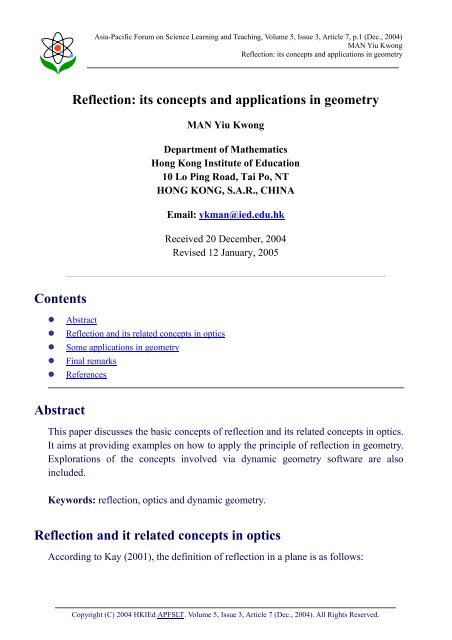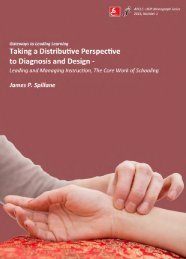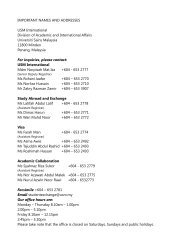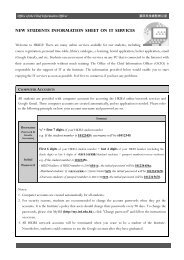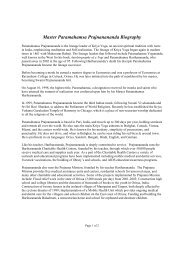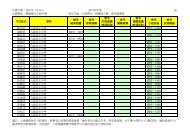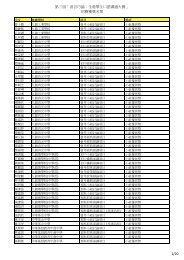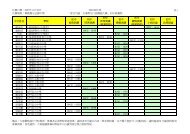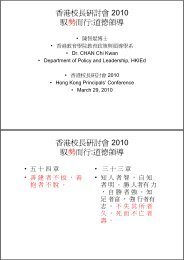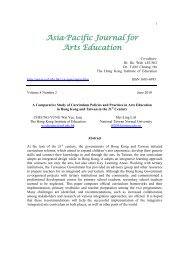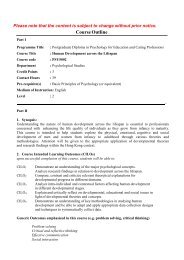Reflection: its concepts and applications in geometry - ResearchGate
Reflection: its concepts and applications in geometry - ResearchGate
Reflection: its concepts and applications in geometry - ResearchGate
Create successful ePaper yourself
Turn your PDF publications into a flip-book with our unique Google optimized e-Paper software.
Asia-Pacific Forum on Science Learn<strong>in</strong>g <strong>and</strong> Teach<strong>in</strong>g, Volume 5, Issue 3, Article 7, p.1 (Dec., 2004)<br />
MAN Yiu Kwong<br />
<strong>Reflection</strong>: <strong>its</strong> <strong>concepts</strong> <strong>and</strong> <strong>applications</strong> <strong>in</strong> <strong>geometry</strong><br />
<strong>Reflection</strong>: <strong>its</strong> <strong>concepts</strong> <strong>and</strong> <strong>applications</strong> <strong>in</strong> <strong>geometry</strong><br />
MAN Yiu Kwong<br />
Department of Mathematics<br />
Hong Kong Institute of Education<br />
10 Lo P<strong>in</strong>g Road, Tai Po, NT<br />
HONG KONG, S.A.R., CHINA<br />
Email: ykman@ied.edu.hk<br />
Received 20 December, 2004<br />
Revised 12 January, 2005<br />
Contents<br />
• Abstract<br />
• <strong>Reflection</strong> <strong>and</strong> <strong>its</strong> related <strong>concepts</strong> <strong>in</strong> optics<br />
• Some <strong>applications</strong> <strong>in</strong> <strong>geometry</strong><br />
• F<strong>in</strong>al remarks<br />
• References<br />
Abstract<br />
This paper discusses the basic <strong>concepts</strong> of reflection <strong>and</strong> <strong>its</strong> related <strong>concepts</strong> <strong>in</strong> optics.<br />
It aims at provid<strong>in</strong>g examples on how to apply the pr<strong>in</strong>ciple of reflection <strong>in</strong> <strong>geometry</strong>.<br />
Explorations of the <strong>concepts</strong> <strong>in</strong>volved via dynamic <strong>geometry</strong> software are also<br />
<strong>in</strong>cluded.<br />
Keywords: reflection, optics <strong>and</strong> dynamic <strong>geometry</strong>.<br />
<strong>Reflection</strong> <strong>and</strong> it related <strong>concepts</strong> <strong>in</strong> optics<br />
Accord<strong>in</strong>g to Kay (2001), the def<strong>in</strong>ition of reflection <strong>in</strong> a plane is as follows:<br />
Copyright (C) 2004 HKIEd APFSLT. Volume 5, Issue 3, Article 7 (Dec., 2004). All Rights Reserved.
Asia-Pacific Forum on Science Learn<strong>in</strong>g <strong>and</strong> Teach<strong>in</strong>g, Volume 5, Issue 3, Article 7, p.2 (Dec., 2004)<br />
MAN Yiu Kwong<br />
<strong>Reflection</strong>: <strong>its</strong> <strong>concepts</strong> <strong>and</strong> <strong>applications</strong> <strong>in</strong> <strong>geometry</strong><br />
Def<strong>in</strong>ition: If a transformation f has the property that some fixed l<strong>in</strong>e l is the<br />
perpendicular bisector of the segment PP' for any po<strong>in</strong>t P <strong>in</strong> the plane <strong>and</strong> P' = f(P),<br />
then f is a reflection with respect to l. The l<strong>in</strong>e l is called the l<strong>in</strong>e of reflection.<br />
The po<strong>in</strong>t P' is called the image of reflection of P. The def<strong>in</strong>ition implies that P <strong>and</strong> P'<br />
are located at the opposite sides of l <strong>and</strong> they are equidistant from l. It is a basic<br />
property of reflection. A related concept <strong>in</strong> optics is the law of reflection, which states<br />
that the angle of <strong>in</strong>cidence (the angle between the <strong>in</strong>com<strong>in</strong>g ray <strong>and</strong> the normal to the<br />
reflect<strong>in</strong>g surface) is equal to the angle of reflection (the angle between the outgo<strong>in</strong>g<br />
ray <strong>and</strong> the normal), as illustrated <strong>in</strong> Figure 1.<br />
θ<br />
2<br />
θ<br />
1<br />
θ<br />
1<br />
= θ 2<br />
Figure 1<br />
This phenomenon is due to the Fermat's pr<strong>in</strong>ciple, which states that light pass<strong>in</strong>g<br />
through a homogeneous medium (such as air) follows the shortest distance, <strong>in</strong> order to<br />
m<strong>in</strong>imize energy (see Gay, D., 1998 <strong>and</strong> Hecht, E., 1998). The mathematical reason<br />
beh<strong>in</strong>d this law of optics can be expla<strong>in</strong>ed <strong>in</strong> Figure 2, where D' denotes the image of<br />
reflection of D. S<strong>in</strong>ce the ray of light takes a path so as to m<strong>in</strong>imize the total distance<br />
of travel DE+EC (= D'E+EC), therefore D', E <strong>and</strong> C must be coll<strong>in</strong>ear. Hence, we<br />
have ∠CEA = ∠D'EB =∠DEB <strong>and</strong> so θ 1 = 90 o - ∠DEB = 90 o - ∠CEA = θ 2 .<br />
Copyright (C) 2004 HKIEd APFSLT. Volume 5, Issue 3, Article 7 (Dec., 2004). All Rights Reserved.
Asia-Pacific Forum on Science Learn<strong>in</strong>g <strong>and</strong> Teach<strong>in</strong>g, Volume 5, Issue 3, Article 7, p.3 (Dec., 2004)<br />
MAN Yiu Kwong<br />
<strong>Reflection</strong>: <strong>its</strong> <strong>concepts</strong> <strong>and</strong> <strong>applications</strong> <strong>in</strong> <strong>geometry</strong><br />
Figure 2<br />
Us<strong>in</strong>g a dynamic <strong>geometry</strong> software, such as W<strong>in</strong>Geom or Sketchpad, this result can<br />
be further exemplified or explored by add<strong>in</strong>g an arbitrary po<strong>in</strong>t P on AB <strong>and</strong> then<br />
measure the total distance traveled by the light ray from A to E. By dragg<strong>in</strong>g the po<strong>in</strong>t<br />
P along AB, we can see that DP+PC (= D'P+PC) is always greater than DE+EC (=<br />
D'E+EC = D'C), provided P <strong>and</strong> E are dist<strong>in</strong>ct po<strong>in</strong>ts, as shown <strong>in</strong> Figure 3. In fact, a<br />
careful study of the diagram reveals that it is simply a basic result <strong>in</strong> Euclidean<br />
Geometry, which states that the total length of any two sides of a triangle is always<br />
greater than the length of the third side.<br />
Figure 3<br />
Copyright (C) 2004 HKIEd APFSLT. Volume 5, Issue 3, Article 7 (Dec., 2004). All Rights Reserved.
Asia-Pacific Forum on Science Learn<strong>in</strong>g <strong>and</strong> Teach<strong>in</strong>g, Volume 5, Issue 3, Article 7, p.4 (Dec., 2004)<br />
MAN Yiu Kwong<br />
<strong>Reflection</strong>: <strong>its</strong> <strong>concepts</strong> <strong>and</strong> <strong>applications</strong> <strong>in</strong> <strong>geometry</strong><br />
Some <strong>applications</strong> <strong>in</strong> <strong>geometry</strong><br />
We now illustrate how to apply the pr<strong>in</strong>ciple of reflection <strong>in</strong> <strong>geometry</strong> <strong>in</strong> the follow<strong>in</strong>g<br />
examples.<br />
Example 1 (The Cowboy Problem)<br />
In Figure 4, a cowboy is located at C. Before rid<strong>in</strong>g on his horse to the campsite S, he<br />
wants to ride his horse to get some grass at the edge of the field <strong>and</strong> then go to the<br />
river for a dr<strong>in</strong>k. What is the shortest path from C to the edge of the grass field, to the<br />
river <strong>and</strong> then to S?<br />
Grass<br />
River<br />
Figure 4<br />
To start off, we have to look for the positions of the po<strong>in</strong>ts P <strong>and</strong> Q, where the cowboy<br />
stops at the edge of the field <strong>and</strong> at the river, respectively. How can we locate these<br />
two po<strong>in</strong>ts? First, we f<strong>in</strong>d the mirror images C' <strong>and</strong> S' by reflections. Next, we jo<strong>in</strong> C'<br />
<strong>and</strong> S' to obta<strong>in</strong> a l<strong>in</strong>e segment. The <strong>in</strong>tersections between this l<strong>in</strong>e segment <strong>and</strong> the<br />
edges of the field <strong>and</strong> the river will fix the positions of P <strong>and</strong> Q. Thus, the shortest<br />
path required is CPQS, as shown <strong>in</strong> Figure 5.<br />
Copyright (C) 2004 HKIEd APFSLT. Volume 5, Issue 3, Article 7 (Dec., 2004). All Rights Reserved.
Asia-Pacific Forum on Science Learn<strong>in</strong>g <strong>and</strong> Teach<strong>in</strong>g, Volume 5, Issue 3, Article 7, p.5 (Dec., 2004)<br />
MAN Yiu Kwong<br />
<strong>Reflection</strong>: <strong>its</strong> <strong>concepts</strong> <strong>and</strong> <strong>applications</strong> <strong>in</strong> <strong>geometry</strong><br />
Figure 5<br />
To prove <strong>its</strong> correctness, we first note that CP + PQ + QS = C'P + PQ + QS', which<br />
means the total length of the path is equal to the length of C'S'. Now, suppose the<br />
cowboy stops at other arbitrary po<strong>in</strong>ts on the edges, say P' <strong>and</strong> Q'. By reflections, the<br />
total distance traveled will be equal to C'P' + P'Q' + Q'S', which is greater than C'S'<br />
because C'P'Q'S' is not a straight l<strong>in</strong>e, as illustrated <strong>in</strong> Figure 6. We can see that the<br />
built-<strong>in</strong> measurement tool of dynamic <strong>geometry</strong> software is quite convenient for<br />
illustration or self-exploration of the <strong>concepts</strong> <strong>in</strong>volved.<br />
Figure 6<br />
Copyright (C) 2004 HKIEd APFSLT. Volume 5, Issue 3, Article 7 (Dec., 2004). All Rights Reserved.
Asia-Pacific Forum on Science Learn<strong>in</strong>g <strong>and</strong> Teach<strong>in</strong>g, Volume 5, Issue 3, Article 7, p.6 (Dec., 2004)<br />
MAN Yiu Kwong<br />
<strong>Reflection</strong>: <strong>its</strong> <strong>concepts</strong> <strong>and</strong> <strong>applications</strong> <strong>in</strong> <strong>geometry</strong><br />
Example 2 (The Billiard Ball Problem)<br />
In Figure 7, a billiard ball is placed at a po<strong>in</strong>t D <strong>in</strong> a triangular billiard table ABC. If<br />
the ball is projected to the side AB, <strong>and</strong> rebounds to BC <strong>and</strong> then to CA, what is the<br />
path of the ball if it can return to D after the three rebounds? Assume there is no<br />
energy lost when the ball h<strong>its</strong> the sides of the table.<br />
Figure 7<br />
First, we have to look for the positions of the po<strong>in</strong>ts P, Q <strong>and</strong> R, where the ball<br />
rebounds from AB, BC <strong>and</strong> CA, respectively. Apply<strong>in</strong>g reflections is a good start, so<br />
we f<strong>in</strong>d the mirror images D 1 <strong>and</strong> D 2 by reflections, with respect to AB <strong>and</strong> CA,<br />
respectively. Although we do not know where are the locations of P, Q <strong>and</strong> R yet, we<br />
can get some ideas by add<strong>in</strong>g an arbitrary po<strong>in</strong>t Q' on BC <strong>and</strong> then draw the l<strong>in</strong>e<br />
segments Q'D 1 <strong>and</strong> Q'D 2 , as shown <strong>in</strong> Figure 8. It is easy to see that the angle of<br />
<strong>in</strong>cidence is equal to the angle of reflection at either E or F because ∠DEA = ∠<br />
Q'EC <strong>and</strong> ∠DFA = ∠Q'FB. However, ∠EQ'C may not be equal to ∠FQ'B. Aga<strong>in</strong>,<br />
a dynamic <strong>geometry</strong> software is a good tool for us to explore the exact position of Q<br />
by dragg<strong>in</strong>g Q' along BC <strong>and</strong> allow us to observe the measures of ∠EQ'C <strong>and</strong> ∠<br />
FQ'B.<br />
Copyright (C) 2004 HKIEd APFSLT. Volume 5, Issue 3, Article 7 (Dec., 2004). All Rights Reserved.
Asia-Pacific Forum on Science Learn<strong>in</strong>g <strong>and</strong> Teach<strong>in</strong>g, Volume 5, Issue 3, Article 7, p.7 (Dec., 2004)<br />
MAN Yiu Kwong<br />
<strong>Reflection</strong>: <strong>its</strong> <strong>concepts</strong> <strong>and</strong> <strong>applications</strong> <strong>in</strong> <strong>geometry</strong><br />
Figure 8<br />
Figure 9 shows the desired position of Q' <strong>and</strong> so we can replace the labels F, Q' <strong>and</strong> E<br />
by P, Q <strong>and</strong> R, respectively, to obta<strong>in</strong> the path of the ball <strong>in</strong> Figure 10.<br />
Figure 9<br />
Copyright (C) 2004 HKIEd APFSLT. Volume 5, Issue 3, Article 7 (Dec., 2004). All Rights Reserved.
Asia-Pacific Forum on Science Learn<strong>in</strong>g <strong>and</strong> Teach<strong>in</strong>g, Volume 5, Issue 3, Article 7, p.8 (Dec., 2004)<br />
MAN Yiu Kwong<br />
<strong>Reflection</strong>: <strong>its</strong> <strong>concepts</strong> <strong>and</strong> <strong>applications</strong> <strong>in</strong> <strong>geometry</strong><br />
Figure 10<br />
A further exploration by dynamic <strong>geometry</strong> software also reveals that the mirror<br />
image of D 1 with respect to BC, say D 3 , must lie on the extension of D 2 Q. It is<br />
because ∠PQB = ∠D3QB = ∠RQC, <strong>and</strong> so D 2 , Q <strong>and</strong> D 3 are coll<strong>in</strong>ear, as shown<br />
<strong>in</strong> Figure 11. Hence, we know that a quick solution to this billiard ball problem is to<br />
f<strong>in</strong>d the mirror images D 1 , D 2 <strong>and</strong> D 3 first, <strong>and</strong> draw the l<strong>in</strong>e segment D 2 D 3 to locate<br />
the positions of R <strong>and</strong> Q, <strong>and</strong> then draw the l<strong>in</strong>e segment D 1 Q to locate the position of<br />
P. Jo<strong>in</strong><strong>in</strong>g the po<strong>in</strong>ts D, P, Q <strong>and</strong> R will give us the path required.<br />
Figure 11<br />
Copyright (C) 2004 HKIEd APFSLT. Volume 5, Issue 3, Article 7 (Dec., 2004). All Rights Reserved.
Asia-Pacific Forum on Science Learn<strong>in</strong>g <strong>and</strong> Teach<strong>in</strong>g, Volume 5, Issue 3, Article 7, p.9 (Dec., 2004)<br />
MAN Yiu Kwong<br />
<strong>Reflection</strong>: <strong>its</strong> <strong>concepts</strong> <strong>and</strong> <strong>applications</strong> <strong>in</strong> <strong>geometry</strong><br />
In fact, we can further deduce that the ball can return to <strong>its</strong> orig<strong>in</strong>al position provided<br />
the l<strong>in</strong>e segment D 2 D 3 <strong>in</strong>tersects with the l<strong>in</strong>e segments BC <strong>and</strong> CA. However, we<br />
have to po<strong>in</strong>t out that this example is a slight deviation to the real-life situation <strong>in</strong><br />
which the energy lost is normally <strong>in</strong>evitable <strong>and</strong> the angle of <strong>in</strong>cidence need not be<br />
equal to the angle of reflection <strong>in</strong> such a case.<br />
F<strong>in</strong>al remarks<br />
This paper discusses the basic <strong>concepts</strong> of reflection <strong>and</strong> <strong>its</strong> related <strong>concepts</strong> <strong>in</strong> optics.<br />
It aims at provid<strong>in</strong>g examples on how to apply the pr<strong>in</strong>ciple of reflection <strong>in</strong> <strong>geometry</strong>.<br />
The approach adopted to expla<strong>in</strong> the ideas beh<strong>in</strong>d the method of solutions, via<br />
dynamic <strong>geometry</strong> software, is based on the author’s own teach<strong>in</strong>g experience. We<br />
hope the readers would f<strong>in</strong>d the discussions useful <strong>and</strong> be able to apply the same ideas<br />
to solve other related problems or use the examples <strong>in</strong> their own teach<strong>in</strong>g, wherever<br />
appropriate.<br />
Reference<br />
1. Kay, D.C. (2001). College <strong>geometry</strong>: A discovery approach with the Geometer's Sketchpad.<br />
New York: Addison Wesley.<br />
2. Gay, D. (1998). Geometry by discovery. New York: John Wiley & Sons.<br />
3. Hecht, E. (1998). Optics (3 rd edition). New York: Addison Wesley.<br />
Copyright (C) 2004 HKIEd APFSLT. Volume 5, Issue 3, Article 7 (Dec., 2004). All Rights Reserved.


